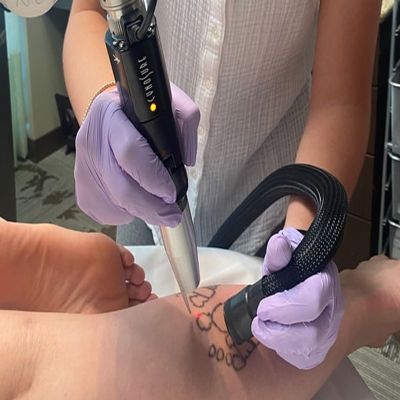When considering laser tattoo removal, one of the most common questions is, "How long does it take for a tattoo to fade after laser treatment?" This concern is particularly relevant for those seeking removal services from a reputable Laser Tattoo Removal Clinic in Oman. The timeline for tattoo fading can vary significantly based on several factors, including the tattoo's size, color, location, and skin type. In this comprehensive guide, we will explore the various aspects that influence how quickly your tattoo will fade post-treatment, providing you with a clearer understanding of what to expect during the process.

Understanding the Laser Tattoo Removal Process
Laser tattoo removal is a procedure that uses high-intensity light beams to break down the ink particles in a tattoo. Each session targets different layers of the tattoo, gradually fading the ink. The body’s immune system then naturally removes these broken-down particles over time. The number of sessions required and the speed at which the tattoo fades depends on various factors, which we will discuss in the following sections.
Factors Influencing Tattoo Fading Time
1. Tattoo Size and Location
The size and location of your tattoo play a significant role in how long it takes to fade. Larger tattoos or those located on areas with poor blood circulation, such as the lower legs or feet, may take longer to fade compared to smaller tattoos or those on areas with better circulation, like the arms or torso.
2. Tattoo Color and Ink Density
Different colors absorb laser light at different rates. Black ink, which is the easiest to remove, tends to fade faster than other colors. Bright colors like green and blue may require more sessions and therefore more time to fade. Additionally, the density of the ink also affects the fading process; heavily inked areas take longer to break down.
3. Skin Type and Immune Response
Your skin type and immune system efficiency significantly influence how long it takes for your tattoo to fade. Individuals with lighter skin tones typically see faster results, as the laser targets the ink more effectively. A strong immune response helps in quickly removing the ink particles from the body, accelerating the fading process.
Post-Treatment Care for Optimal Fading
1. Importance of Following Aftercare Instructions
Aftercare is crucial for effective tattoo fading. Following the guidelines provided by your Laser Tattoo Removal Clinic in Oman ensures that your skin heals properly between sessions, reducing the risk of complications and aiding in faster fading.
2. Keeping the Treated Area Moisturized
Applying a recommended moisturizer helps keep the skin hydrated and promotes healing. It also helps reduce scabbing, which can delay the fading process if not properly managed.
3. Avoiding Sun Exposure
Protecting the treated area from sun exposure is vital. UV rays can cause skin irritation and slow down the fading process. It is recommended to use a high-SPF sunscreen or cover the area to prevent any potential damage.
Expected Timeline for Tattoo Fading
1. Initial Fading After the First Session
Many people notice some fading after the first session, but this is often minimal. The most significant fading typically occurs after multiple sessions, with the ink becoming progressively lighter.
2. Fading Progress Over Multiple Sessions
The number of sessions required varies; most tattoos require 6-12 sessions spaced 6-8 weeks apart. With each session, the tattoo should fade more, although certain stubborn colors may take longer.
3. Long-Term Fading and Final Results
Complete fading can take several months to over a year, depending on the factors mentioned earlier. Patience is key, as the body continues to flush out ink particles long after the final session.
Common Challenges in Tattoo Fading
1. Stubborn Colors and Resistant Ink
Certain ink colors, particularly light blues and greens, may resist fading and require more treatment sessions. In some cases, a specialized laser may be needed to target these difficult colors effectively.
2. Skin Reactions and Healing Issues
Some individuals may experience skin reactions that slow the fading process. These can include hyperpigmentation, hypopigmentation, or scarring, which, although rare, can prolong the timeline.
Alternatives to Speed Up Tattoo Fading
1. Supplements and Skincare Regimens
Some clinics may recommend supplements that boost immune function or specific skincare products that promote faster healing. However, it’s essential to consult with your Laser Tattoo Removal Clinic in Oman before trying any new products or treatments.
2. Combined Treatment Approaches
In some cases, combining laser treatments with other procedures, such as dermabrasion, can enhance fading. This combination approach should be discussed with your specialist to ensure it’s safe and effective for your skin type and tattoo.
Conclusion
The timeline for a tattoo to fade after laser treatment varies greatly depending on several individual factors. By understanding these factors and following the proper aftercare instructions from your Laser Tattoo Removal Clinic in Oman, you can help ensure the most effective and timely fading of your tattoo. Remember that patience and consistency are crucial in achieving the desired results, and with the right approach, you can look forward to clear skin once again.
